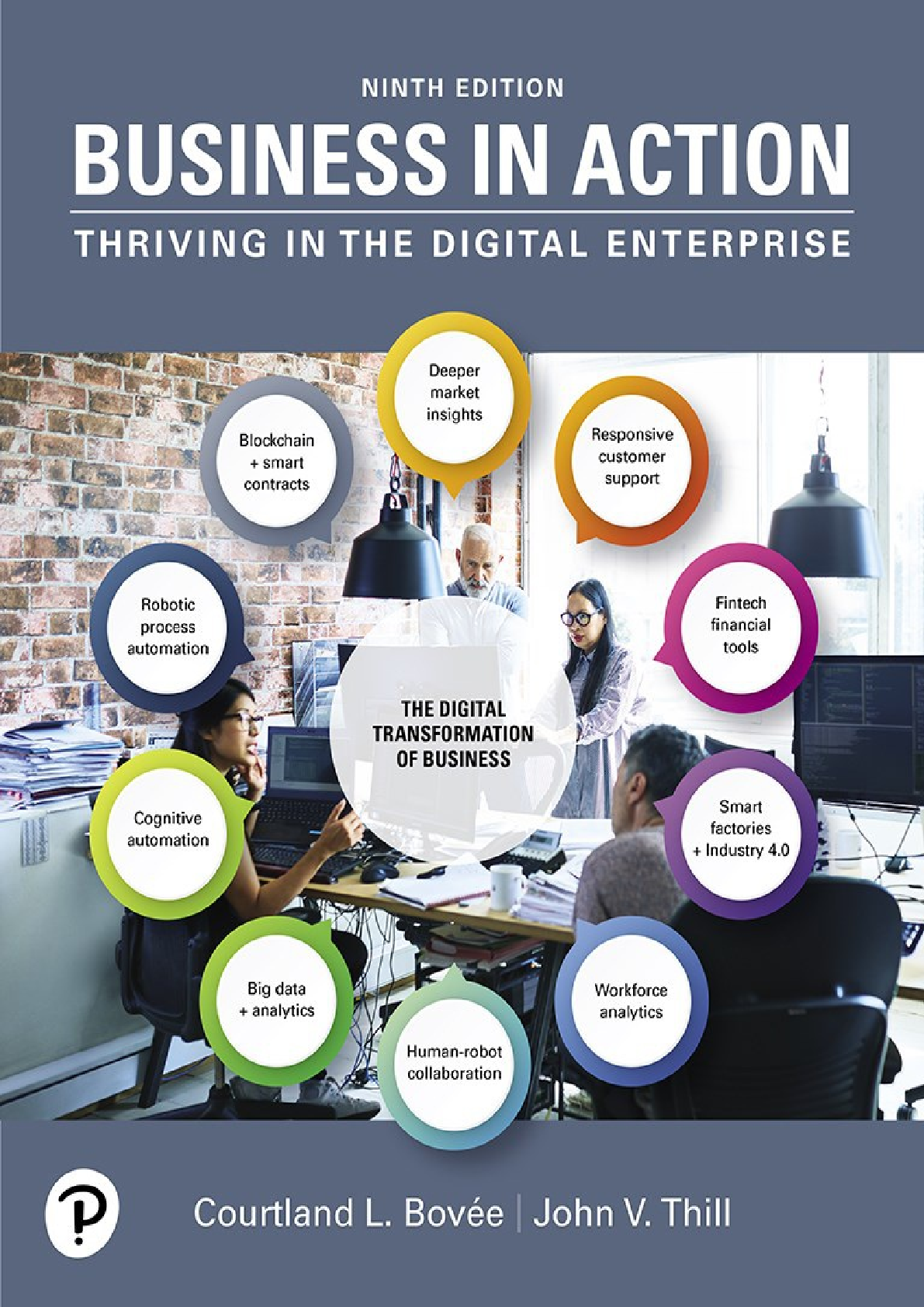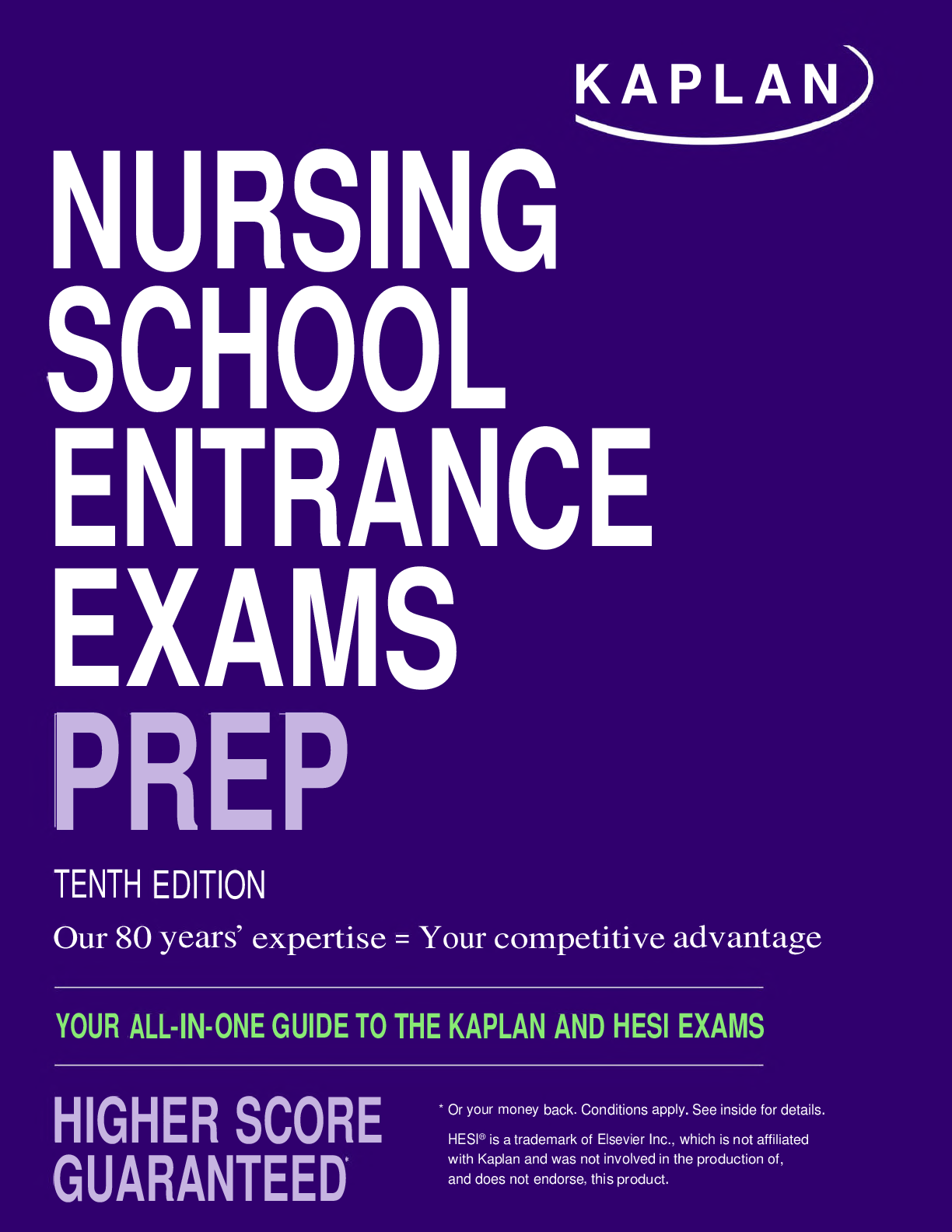Business > eBook-PDF > eBook [PDF] Business in Action, 9th Edition By Courtland Bovee, John Thill (All)
eBook [PDF] Business in Action, 9th Edition By Courtland Bovee, John Thill
Document Content and Description Below
eBook [PDF] Business in Action, 9th Edition By Courtland Bovee, John Thill Business in Action Contents in Brief Contents New to This Edition Solving Teaching and Learning Challenges Developing E... mployability Skills Instructor Teaching Resources Prologue Part 1 Setting the Stage: The Business of Business 1 Developing a Business Mindset LEARNING OBJECTIVES Introduction Understanding What Businesses Do Adding Value: The Business of Business Competing to Attract and Satisfy Customers Accepting Risks in the Pursuit of Rewards Identifying Major Types of Businesses Learning Objective 1: Summary: Critical Thinking: It’s Your Business: Key Terms to Know: Making the Leap from Buyer to Seller Seeing Business from the Inside Out Appreciating the Role of Business in Society Using This Course to Jump-Start Your Career Learning Objective 2: Summary: Critical Thinking: It’s Your Business: Key Term To Know: Recognizing the Multiple Environments of Business The Social Environment The Technological Environment The Economic Environment The Legal and Regulatory Environment The Market Environment Learning Objective 3: Summary: Critical Thinking: It’s Your Business: Key Terms to Know: Identifying the Major Functional Areas in a Business Enterprise Research and Development Manufacturing, Production, and Operations Marketing, Sales, Distribution, and Customer Support Finance and Accounting Human Resources Business Services Learning Objective 4: Summary: Critical Thinking: It’s Your Business: Key Terms to Know: Exploring Careers in Business Operations Manager Human Resources Specialist Information Technology Manager Marketing Specialist Sales Professional Accountant Financial Manager Learning Objective 5: Summary: Critical Thinking: It’s Your Business: Key Term To Know: Achieving Professionalism Striving to Excel Being Dependable and Accountable Being a Team Player Demonstrating Etiquette Communicating Effectively Making Ethical Decisions Learning Objective 6: Summary: Critical Thinking: It’s Your Business: Key Terms to Know: Thriving in the Digital Enterprise: Disruptive Technologies and Digital Transformation Disruptive Innovations Digital Transformation Learning Objective 7: Summary: Critical Thinking: It’s Your Business: Key Terms to Know: Developing Skills for Your Career End of Chapter Key Terms Test Your Knowledge Questions for Review Questions for Analysis Questions for Application Expand Your Knowledge Discovering Career Opportunities Intelligent Business Technology: Text Mining Practice Your Skills Resolving Ethical Dilemmas Growing as a Professional Sharpening Your Communication Skills Building Your Team Skills Developing Your Research Skills Endnotes 2 Economics, Money, and Banking LEARNING OBJECTIVES Introduction What Is This Thing Called the Economy? Factors of Production The Economic Impact of Scarcity Economic Measures and Monitors Price Indexes National Economic Output Learning Objective 1: Summary: Critical Thinking: It’s Your Business: Key Terms to Know: Economic Systems The Spectrum of Economic Systems Nationalization and Privatization Government’s Role in a Free-Market System Protecting Stakeholders Fostering Competition Antitrust Legislation Merger and Acquisition Approvals Encouraging Innovation and Economic Development Stabilizing and Stimulating the Economy Learning Objective 2: Summary: Critical Thinking: It’s Your Business: Key Terms to Know: The Forces of Demand and Supply Understanding Demand Understanding Supply Understanding How Demand and Supply Interact Learning Objective 3: Summary: Critical Thinking: It’s Your Business: Key Terms to Know: The Macro View: Understanding How an Economy Operates Competition in a Free-Market System Business Cycles Unemployment Inflation Learning Objective 4: Summary: Critical Thinking: It’s Your Business: Key Terms to Know: Money’s Role in Business The Meaning of Money Fiat Money and Cryptocurrency The Money Supply Learning Objective 5: Summary: Critical Thinking: It’s Your Business: Key Terms to Know: Banking Institutions and Services The Federal Reserve The Fed’s Major Responsibilities The Fed’s Tools for Implementing Monetary Policy The Federal Funds Rate The Discount Rate Other Government Banking Agencies and Institutions Investment Banks Commercial Banks Other Financial Services Banking’s Role in the Economy The Too-Big-to-Fail Dilemma The Boundaries of Investment Banking and Commercial Banking Learning Objective 6: Summary: Critical Thinking: It’s Your Business: Key Terms to Know: Thriving in the Digital Enterprise: Fintech Making Financial Services More Inclusive Improving THE Efficiency of Financial Activities Strengthening THE Security of Financial Systems Improving the Customer Experience in Financial Services Enhancing Financial Decision-Making Learning Objective 7: Summary: Critical Thinking: It’s Your Business: Key Terms to Know: End of Chapter Key Terms Test Your Knowledge Questions for Review Questions for Analysis Questions for Application Expand Your Knowledge Discovering Career Opportunities Intelligent Business Technology: Robo Advisers Practice Your Skills Resolving Ethical Dilemmas Growing as a Professional Sharpening Your Communication Skills Building Your Team Skills Developing Your Research Skills Endnotes 3 The Global Marketplace LEARNING OBJECTIVES Introduction Fundamentals of International Trade Why Nations Trade How International Trade Is Measured Foreign Exchange Rates and Currency Valuations Learning Objective 1: Summary: Critical Thinking: It’s Your Business: Key Terms to Know: Conflicts in International Trade Free Trade Government Intervention in International Trade Learning Objective 2: Summary: Critical Thinking: It’s Your Business: Key Terms to Know: International Trade Organizations Organizations Facilitating International Trade The World Trade Organization The International Monetary Fund The World Bank Trading Blocs North American Free Trade Agreement The European Union The Asia-Pacific Economic Cooperation Learning Objective 3: Summary: Critical Thinking: It’s Your Business: Key Term To Know: The Global Business Environment Cultural Differences in the Global Business Environment Legal Differences in the Global Business Environment Tax Havens Bribery Learning Objective 4: Summary: Critical Thinking: It’s Your Business: Key Terms to Know: Forms of International Business Activity Importing and Exporting International Licensing International Franchising International Strategic Alliances and Joint Ventures Foreign Direct Investment Learning Objective 5: Summary: Critical Thinking: It’s Your Business: Key Terms to Know: Strategic Approaches to International Markets Organizational Strategies for International Expansion Functional Strategies for International Expansion Learning Objective 6: Summary: Critical Thinking: It’s Your Business: Key Terms to Know: Thriving in the Digital Enterprise: AI-Assisted Translation Text Translation Real-Time Voice Translation Learning Objective 7: Summary: Critical Thinking: It’s Your Business: Key Term To Know: End of Chapter Key Terms Test Your Knowledge Questions for Review Questions for Analysis Questions for Application Expand Your Knowledge Discovering Career Opportunities Intelligent Business Technology: Automated Translation Practice Your Skills Resolving Ethical Dilemmas Growing as a Professional Sharpening Your Communication Skills Building Your Team Skills Developing Your Research Skills Endnotes 4 Business Ethics and Corporate Social Responsibility LEARNING OBJECTIVES Introduction Ethics in Contemporary Business Defining Ethical Behavior Forces That Promote Unethical Behavior Management Pressure and Corporate Culture Millions of Phony Bank Accounts Falsified Pollution Data A Willful Blindness to Harm The Opioid Crisis The Destructive Downside of Social Media A Sense of Impunity Strategies for Supporting Ethical Behavior Guidelines for Making Ethical Decisions Learning Objective 1: Summary: Critical Thinking: It’s Your Business: Key Terms to Know: Corporate Social Responsibility The Relationship Between Business and Society Philanthropy Versus Strategic CSR Learning Objective 2: Summary: Critical Thinking: It’s Your Business: Key Term To Know: Perspectives on Corporate Social Responsibility Minimalist CSR Defensive CSR Cynical CSR The Proactive Stance: Moving Beyond CSR Resolving the CSR Dilemma Learning Objective 3: Summary: Critical Thinking: It’s Your Business: Key Terms to Know: CSR: The Natural Environment Efforts to Conserve Resources and Reduce Pollution The Trend Toward Sustainability Learning Objective 4: Summary: Critical Thinking: It’s Your Business: Key Terms to Know: CSR: Consumers The Right to Buy Safe Products The Right to Be Informed The Right to Choose Which Products to Buy The Right to Be Heard The Right to Digital Security Learning Objective 5: Summary: Critical Thinking: It’s Your Business: Key Term To Know: CSR: Employees The Push for Equality in Employment Affirmative Action People with Disabilities Workplace Safety Learning Objective 6: Summary: Critical Thinking: It’s Your Business: Key Terms to Know: Thriving in the Digital Enterprise: The Ethics of Artificial Intelligence Human Biases Embedded in AI Systems Lack of Transparency and Accountability The Efforts to Make AI a Force for Good Learning Objective 7: Summary: Critical Thinking: It’s Your Business: End of Chapter Key Terms Test Your Knowledge Questions for Review Questions for Analysis Questions for Application Expand Your Knowledge Discovering Career Opportunities Intelligent Business Technology: Assistive Technologies Practice Your Skills Resolving Ethical Dilemmas Growing as a Professional Sharpening Your Communication Skills Building Your Team Skills Developing Your Research Skills Endnotes Part 2 Building the Framework: Business Ownership and Entrepreneurship 5 Forms of Ownership LEARNING OBJECTIVES Introduction Sole Proprietorships Learning Objective 1 Advantages of Sole Proprietorships Disadvantages of Sole Proprietorships Learning Objective 1: Summary: Critical Thinking: It’s Your Business: Key Terms to Know: Partnerships Advantages of Partnerships Disadvantages of Partnerships Keeping It Together: The Partnership Agreement Learning Objective 2: Summary: Critical Thinking: It’s Your Business: Key Terms to Know: Corporations Advantages of Corporations Disadvantages of Corporations Special Types of Corporations Learning Objective 3: Summary: Critical Thinking: It’s Your Business: Key Terms to Know: Corporate Governance Shareholders Board of Directors Corporate Officers Learning Objective 4: Summary: Critical Thinking: It’s Your Business: Key Terms to Know: Mergers and Acquisitions Advantages of Mergers and Acquisitions Disadvantages of Mergers and Acquisitions Merger and Acquisition Defenses Learning Objective 5: Summary: Critical Thinking: It’s Your Business: Key Terms to Know: Strategic Alliances and Joint Ventures Strategic Alliances Joint Ventures Learning Objective 6: Summary: Critical Thinking: It’s Your Business: Key Terms to Know: Thriving in the Digital Enterprise: Big Data and Analytics Big Data Analytics Learning Objective 7: Summary: Critical Thinking: It’s Your Business: Key Terms to Know: End of Chapter Key Terms Test Your Knowledge Questions for Review Questions for Analysis Questions for Application Expand Your Knowledge Discovering Career Opportunities Intelligent Business Technology: Data Mining Practice Your Skills Resolving Ethical Dilemmas Growing as a Professional Sharpening Your Communication Skills Building Your Team Skills Developing Your Research Skills Endnotes 6 Entrepreneurship and Small-Business Ownership LEARNING OBJECTIVES Introduction The Big World of Small Business Economic Roles of Small Businesses Characteristics of Small Businesses Learning Objective 1: Summary: Critical Thinking: It’s Your Business: Key Terms to Know: The Entrepreneurial Spirit Why People Start Their Own Companies Qualities of Successful Entrepreneurs Innovating Without Leaving: Intrapreneurship Learning Objective 2: Summary: Critical Thinking: It’s Your Business: Key Terms to Know: The Start-Up Phase: Planning and Launching a New Business Small-Business Ownership Options Blueprint for an Effective Business Plan Lean Business Planning Learning Objective 3: Summary: Critical Thinking: It’s Your Business: Key Terms to Know: The Growth Phase: Nurturing and Sustaining a Young Business The New-Business Failure Rate Pivoting: When a Better Idea Comes Along Advice and Support for Business Owners Government Agencies and Not-for-Profit Organizations Business Partners Mentors and Advisory Boards Networks and Support Groups Business Incubators and Accelerators Learning Objective 4: Summary: Critical Thinking: It’s Your Business: Key Terms to Know: Financing Options for Small Businesses Private Financing Banks and Microlenders Venture Capitalists Angel Investors Credit Cards and Personal Lines of Credit Small Business Administration Assistance Public Financing Crowdfunding Learning Objective 5: Summary: Critical Thinking: It’s Your Business: Key Terms to Know: The Franchise Alternative Types of Franchises The Money Side of Franchising Initial Franchising Costs Ongoing Franchising Costs Advantages of Franchising Disadvantages of Franchising How to Evaluate a Franchising Opportunity Learning Objective 6: Summary: Critical Thinking: It’s Your Business: Key Terms to Know: Thriving in the Digital Enterprise: Machine Learning and Deep Learning Going Deeper with Deep Learning The Business Side of Machine Learning and Deep Learning Learning Objective 7: Summary: Critical Thinking: It’s Your Business: Key Terms to Know: End of Chapter Key Terms Test Your Knowledge Questions for Review Questions for Analysis Questions for Application Expand Your Knowledge Discovering Career Opportunities Intelligent Business Technology: Deep Learning Practice Your Skills Resolving Ethical Dilemmas Growing as a Professional Sharpening Your Communication Skills Building Your Team Skills Developing Your Research Skills Endnotes Part 3 Guiding the Enterprise: Leadership, Organization, and Operations 7 Management Roles, Functions, and Skills LEARNING OBJECTIVES Introduction The Roles of Management Interpersonal Roles Informational Roles Decisional Roles Learning Objective 1: Summary: Critical Thinking: It’s Your Business: Key Term To Know: The Planning Function Defining the Company’s Purpose and Values Assessing Strengths, Weaknesses, Opportunities, and Threats Developing Forecasts Analyzing the Competition Establishing Goals and Objectives Developing Action Plans Learning Objective 2: Summary: Critical Thinking: It’s Your Business: Key Terms to Know: The Organizing Function Top Managers Middle Managers First-Line Managers Learning Objective 3: Summary: Critical Thinking: It’s Your Business: Key Terms to Know: The Leading Function Developing an Effective Leadership Style Coaching and Mentoring Managing Change Building a Positive Organizational Culture Learning Objective 4: Summary: Critical Thinking: It’s Your Business: Key Terms to Know: The Controlling Function The Control Cycle Establishing Performance Standards Measuring Performance and Responding as Needed Crisis Management: Maintaining Control in Extraordinary Circumstances Learning Objective 5: Summary: Critical Thinking: It’s Your Business: Key Terms to Know: Essential Management Skills Interpersonal Skills Technical Skills Conceptual Skills Decision-Making Skills Learning Objective 6: Summary: Critical Thinking: It’s Your Business: Key Terms to Know: Thriving in the Digital Enterprise: Cognitive Automation The Cold Truth About Decision-Making AI to the (Possible) Rescue Learning Objective 7: Summary: Critical Thinking: It’s Your Business: Key Term To Know: End of Chapter Key Terms Test Your Knowledge Questions for Review Questions for Analysis Questions for Application Expand Your Knowledge Discovering Career Opportunities Intelligent Business Technology: Cognitive Automation Practice Your Skills Resolving Ethical Dilemmas Growing as a Professional Sharpening Your Communication Skills Building Your Team Skills Developing Your Research Skills Endnotes 8 Organization and Teamwork LEARNING OBJECTIVES Introduction Designing an Effective Organization Structure Identifying Core Competencies Identifying Job Responsibilities Defining the Chain of Command Span of Management Centralization Versus Decentralization Rethinking Organization in the Age of Agility Learning Objective 1: Summary: Critical Thinking: It’s Your Business: Key Terms to Know: Organizing the Workforce Functional Structures Divisional Structures Matrix Structures Network Structures Learning Objective 2: Summary: Critical Thinking: It’s Your Business: Key Terms to Know: Organizing in Teams What Is a Team? Types of Teams Problem-Solving Teams Self-Managed Teams Functional Teams Cross-Functional Teams Virtual Teams Advantages of Virtual Teams Disadvantages of Virtual Teams Social Networks and Virtual Communities Learning Objective 3: Summary: Critical Thinking: It’s Your Business: Key Terms to Know: Ensuring Team Productivity Advantages and Disadvantages of Working in Teams Characteristics of Effective Teams Learning Objective 4: Summary: Critical Thinking: It’s Your Business: Key Terms to Know: Fostering Teamwork Team Development Team Conflict Sources of Team Conflict Solutions to Team Conflict Learning Objective 5: Summary: Critical Thinking: It’s Your Business: Key Term To Know: Managing an Unstructured Organization Potential Benefits of Unstructured Organizations Potential Challenges of Unstructured Organizations Learning Objective 6: Summary: Critical Thinking: It’s Your Business: Key Term To Know: Thriving in the Digital Enterprise: Taskbots and Robotic Process Automation Taskbots Robotic Process Automation Learning Objective 7: Summary: Critical Thinking: It’s Your Business: Key Terms to Know: End of Chapter Key Terms Test Your Knowledge Questions for Review Questions for Analysis Questions for Application Expand Your Knowledge Discovering Career Opportunities Intelligent Communication Technology: Robotic Process Automation Practice Your Skills Resolving Ethical Dilemmas Growing as a Professional Sharpening Your Communication Skills Building Your Team Skills Developing Your Research Skills Endnotes 9 Production Systems LEARNING OBJECTIVES Introduction The Systems View of Business Thinking in Systems Managing Systems for Peak Performance Learning Objective 1: Summary: Critical Thinking: It’s Your Business: Key Term To Know: Value Chains and Value Webs Extending Organizations with Value Webs The Offshoring Controversy Learning Objective 2: Summary: Critical Thinking: It’s Your Business: Key Terms to Know: Supply Chain Management The Strategic Role of Supply Chain Management Supply Chain Systems and Methods Learning Objective 3: Summary: Critical Thinking: It’s Your Business: Key Terms to Know: Production and Operations Management Lean Systems Mass Production, Customized Production, and Mass Customization Facilities Location and Design Forecasting and Capacity Planning Scheduling Learning Objective 4: Summary: Critical Thinking: It’s Your Business: Key Terms to Know: The Unique Challenges of Service Delivery Perishability Location Constraints Scalability Challenges and Opportunities Performance Variability and Perceptions of Quality Customer Involvement and Service Provider Interaction Learning Objective 5: Summary: Critical Thinking: It’s Your Business: Key Term To Know: Product and Process Quality Quality and Complexity Strategies for Ensuring Product Quality Continuous Improvement Statistical Process Control Six Sigma ISO 9000 Learning Objective 6: Summary: Critical Thinking: It’s Your Business: Key Terms to Know: Thriving in the Digital Enterprise: Industry 4.0 and the Smart Factory Learning Objective 7: Summary: Critical Thinking: It’s Your Business: Key Term To Know: End of Chapter Key Terms Test Your Knowledge Questions for Review Questions for Analysis Questions for Application Expand Your Knowledge Discovering Career Opportunities Intelligent Business Technology Practice Your Skills Resolving Ethical Dilemmas Growing as Professional Sharpening Your Communication Skills Building Your Team Skills Developing Your Research Skills Endnotes Part 4 Supporting the Workforce: Motivation and Human Resources 10 Employee Motivation LEARNING OBJECTIVES Introduction What Motivates Employees to Peak Performance? What Is Motivation? Classical Theories of Motivation Taylor’s Scientific Management The Hawthorne Studies and the “Hawthorne Effect” Maslow’s Hierarchy of Needs Theory X and Theory Y Herzberg’s Two Factors McClelland’s Three Needs Learning Objective 1: Summary: Critical Thinking: It’s Your Business: Key Terms to Know: Explaining Employee Choices Expectancy Theory Equity Theory Learning Objective 2: Summary: Critical Thinking: It’s Your Business: Key Terms to Know: Motivating with Challenging Goals Management by Objectives Risks and Limitations of Goal-Setting Theory Learning Objective 3: Summary: Critical Thinking: It’s Your Business: Key Terms to Know: Redesigning Jobs to Stimulate Performance The Job Characteristics Model Approaches to Modifying Core Job Dimensions Learning Objective 4: Summary: Critical Thinking: It’s Your Business: Key Terms to Know: Reinforcing High-Performance Behavior Types of Reinforcement Unintended Consequences of Reinforcement Learning Objective 5: Summary: Critical Thinking: It’s Your Business: Key Terms to Know: Motivational Strategies Providing Timely and Frequent Feedback Making It Personal Gamifying for Healthy Competition Addressing Workplace Negativity Being an Inspiring Leader Motivating Yourself Learning Objective 6: Summary: Critical Thinking: It’s Your Business: Key Terms to Know: Thriving in the Digital Enterprise: Performance Management Systems Learning Objective 7: Summary: Critical Thinking: It’s Your Business: Key Terms to Know: End of Chapter Key Terms Test Your Knowledge Questions for Review Questions for Analysis Questions for Application Expand Your Knowledge Discovering Career Opportunities Intelligent Business Technology: Performance Management Systems Practice Your Skills Resolving Ethical Dilemmas Growing as a Professional Sharpening Your Communication Skills Building Your Team Skills Developing Your Research Skills Endnotes 11 Human Resources Management LEARNING OBJECTIVES Introduction Guiding the Human Side of Business Contemporary HR Challenges Aligning the Workforce with Business Requirements Creating Safe Workplaces Ensuring Fair Treatment and Equal Opportunity Fairness in Recruiting Fairness in Employee Development Transparent and Inclusive Networking Opportunities Fairness in Project Assignments and Promotion Opportunities Fairness in Compensation Promoting Employee Well-Being The Evolving Role of HR Learning Objective 1: Summary: Critical Thinking: It’s Your Business: Key Terms to Know: Managing a Diverse Workforce Dimensions of Workforce Diversity Age Gender Race and Ethnicity Religion Ability Diversity and Inclusion Initiatives Learning Objective 2: Summary: Critical Thinking: It’s Your Business: Key Terms to Know: Managing the Employment Life Cycle Planning for a Company’s Staffing Needs Evaluating Job Requirements Forecasting Supply and Demand Alternative Work Arrangements Hiring Employees Managing Employee Retirement Terminating Employment Learning Objective 3: Summary: Critical Thinking: It’s Your Business: Key Terms to Know: Developing and Evaluating Employees Appraising Employee Performance Training and Developing Employees Promoting and Reassigning Employees Learning Objective 4: Summary: Critical Thinking: It’s Your Business: Key Terms to Know: Compensating and Supporting Employees Salaries and Wages Incentive Programs Employee Benefits Insurance Retirement Benefits Stock Options Other Employee Benefits Learning Objective 5: Summary: Critical Thinking: It’s Your Business: Key Terms to Know: Understanding the Role of Labor Unions in Today’s Business World Unionization: The Employee’s Perspective Unionization: Management’s Perspective The Future of Organized Labor Learning Objective 6: Summary: Critical Thinking: It’s Your Business: Key Terms to Know: Thriving in the Digital Enterprise: Workforce Analytics Learning Objective 7: Summary: Critical Thinking: It’s Your Business: Key Term To Know: End of Chapter Key Terms Test Your Knowledge Questions for Review Questions for Analysis Questions for Application Expand Your Knowledge Discovering Career Opportunities Intelligent Business Technology: Blind Auditions Practice Your Skills Resolving Ethical Dilemmas Growing as a Professional Sharpening Your Communication Skills Building Your Team Skills Developing Your Research Skills Endnotes Part 5 Satisfying the Customer: Marketing, Sales, and Customer Support 12 The Art and Science of Marketing LEARNING OBJECTIVES Introduction Marketing in a Changing World The Role of Marketing in Society Needs and Wants Exchanges and Transactions The Four Utilities The Marketing Concept Learning Objective 1: Summary: Critical Thinking: It’s Your Business: Key Terms to Know: Challenges in Contemporary Marketing Involving the Customer in the Marketing Process Making Data-Driven Marketing Decisions Marketing with Greater Concern for Ethics and Etiquette Marketing as Part of a Sustainable Business Strategy Creating Satisfying Customer Experiences Learning Objective 2: Summary: Critical Thinking: It’s Your Business: Key Terms to Know: Understanding Today’s Customers The Consumer Decision Process The Organizational Customer Decision Process Learning Objective 3: Summary: Critical Thinking: It’s Your Business: Key Terms to Know: Identifying Market Opportunities Examining the Current Marketing Situation Reviewing Performance Evaluating Competition Examining Internal Strengths and Weaknesses Analyzing the External Environment Assessing Opportunities and Setting Objectives Learning Objective 4: Summary: Critical Thinking: It’s Your Business: Key Terms to Know: Crafting a Marketing Strategy Dividing Markets into Segments Choosing Your Target Markets Staking out a Position in Your Target Markets Learning Objective 5: Summary: Critical Thinking: It’s Your Business: Key Terms to Know: The Marketing Mix Products Pricing Distribution Customer Communication Learning Objective 6: Summary: Critical Thinking: It’s Your Business: Key Terms to Know: Thriving in the Digital Enterprise: Marketing Analytics Major Goals of Marketing Analytics Data Sources for Marketing Analytics Learning Objective 7: Summary: Critical Thinking: It’s Your Business: Key Term To Know: End of Chapter Key Terms Test Your Knowledge Questions for Review Questions for Analysis Questions for Application Expand Your Knowledge Discovering Career Opportunities Intelligent Business Technology: Marketing Analytics Practice Your Skills Resolving Ethical Dilemmas Growing as a Professional Sharpening Your Communication Skills Building Your Team Skills Developing Your Research Skills Endnotes 13 Product Management and Pricing Strategies LEARNING OBJECTIVES Introduction Characteristics of Products Types of Products Consumer Products Industrial and Commercial Products The Product Life Cycle Introduction Growth Maturity Decline Learning Objective 1: Summary: Critical Thinking: It’s Your Business: Key Terms to Know: The New-Product Development Process Idea Generation Idea Screening Business Analysis Prototype Development Test Marketing Commercialization Learning Objective 2: Summary: Critical Thinking: It’s Your Business: Key Terms to Know: Product Identities Brand Name Selection Brand Ownership Packaging Labeling Learning Objective 3: Summary: Critical Thinking: It’s Your Business: Key Terms to Know: Product-Line and Product-Mix Strategies Product Lines Product Mix Product Expansion Strategies Product Strategies for International Markets Learning Objective 4: Summary: Critical Thinking: It’s Your Business: Key Terms to Know: Pricing Strategies Strategic Considerations in Pricing Cost Structure and Break-Even Analysis Learning Objective 5: Summary: Critical Thinking: It’s Your Business: Key Terms to Know: Pricing Methods Foundational Pricing Methods Cost-Based Pricing Value-Based Pricing Competition-Based Pricing Situational Pricing Methods Algorithmic Pricing Life-Cycle Pricing Loss-Leader Pricing Auctions and Participative Pricing Free and Freemium Pricing Subscription Pricing Price Adjustment Tactics Learning Objective 6: Summary: Critical Thinking: It’s Your Business: Key Terms to Know: Thriving in the Digital Enterprise: Virtual and Augmented Reality Virtual Reality Augmented Reality Learning Objective 7: Summary: Critical Thinking: It’s Your Business: Key Terms to Know: End of Chapter Key Terms Test Your Knowledge Questions for Review Questions for Analysis Questions for Application Expand Your Knowledge Discovering Career Opportunities Intelligent Business Technologies: Yield Management Practice Your Skills Resolving Ethical Dilemmas Growing as a Professional Sharpening Your Communication Skills Building Your Team Skills Developing Your Research Skills Endnotes 14 Customer Communication and Product Distribution LEARNING OBJECTIVES Introduction Customer Communication: Challenges, Strategies, and Issues Establishing Communication Goals Defining Customer Messages Assembling the Communication Mix Inbound Versus Outbound Marketing Integrated Marketing Communications Communication Laws and Ethics Learning Objective 1: Summary: Critical Thinking: It’s Your Business: Key Terms to Know: Advertising and Direct Response Marketing Advertising Advertising Appeals Advertising Media Direct Response Marketing Learning Objective 2: Summary: Critical Thinking: It’s Your Business: Key Terms to Know: Personal Selling Contemporary Personal Selling The Personal Selling Process Learning Objective 3: Summary: Critical Thinking: It’s Your Business: Key Terms to Know: Sales Promotion Consumer Promotions Trade Promotions Learning Objective 4: Summary: Critical Thinking: It’s Your Business: Key Terms to Know: Social Media and Public Relations Social Media in the Marketing Process Marketing Communication Strategies for Social Media Brand Communities Social Customer Care Public Relations Learning Objective 5: Summary: Critical Thinking: It’s Your Business: Key Terms to Know: Product Distribution and Marketing Intermediaries The Role of Marketing Intermediaries Wholesaling and Industrial Distribution Retailing Retailing’s Role in the Buying Process The Challenging Economics of Retailing The Outlook for Retailing: Innovation, Disruption, and the Great Divide Manufacturers’ Distribution Decisions Learning Objective 6: Summary: Critical Thinking: It’s Your Business: Key Terms to Know: Thriving in the Digital Enterprise: Augmented and Automated Writing Augmented Writing Automated Writing Learning Objective 7: Summary: Critical Thinking: It’s Your Business: Key Terms to Know: End of Chapter Key Terms Test Your Knowledge Questions for Review Questions for Analysis Questions for Application Expand Your Knowledge Discovering Career Opportunities Intelligent Communication Technology: Individualized Advertising Practice Your Skills Resolving Ethical Dilemmas Growing as a Professional Sharpening Your Communication Skills Building Your Team Skills Developing Your Research Skills Endnotes Part 6 Managing the Money: Accounting and Financial Resources 15 Financial Information and Accounting Concepts LEARNING OBJECTIVES Introduction Understanding Accounting What Accountants Do Private Accountants Public Accountants Learning Objective 1: Summary: Critical Thinking: It’s Your Business: Key Terms to Know: Major Accounting Rules Generally Accepted Accounting Principles (GAAP) Non-GAAP Metrics Global Reporting Standards Sarbanes-Oxley Learning Objective 2: Summary: Critical Thinking: It’s Your Business: Key Terms to Know: Fundamental Accounting Concepts The Accounting Equation Double-Entry Bookkeeping and the Matching Principle Learning Objective 3: Summary: Critical Thinking: It’s Your Business: Key Terms to Know: Using Financial Statements: The Balance Sheet Understanding Financial Statements Balance Sheet Assets Liabilities Owners’ Equity Learning Objective 4: Summary: Critical Thinking: It’s Your Business: Key Terms to Know: Using Financial Statements: Income and Cash Flow Statements Income Statement Statement of Cash Flows Learning Objective 5: Summary: Critical Thinking: It’s Your Business: Key Terms to Know: Analyzing Financial Statements Trend Analysis Ratio Analysis Types of Financial Ratios Profitability Ratios Liquidity Ratios Activity Ratios Leverage, or Debt, Ratios Learning Objective 6: Summary: Critical Thinking: It’s Your Business: Key Terms to Know: Thriving in the Digital Enterprise: Distributed Ledgers and Blockchain The Not-So-Simple Process of Recording Transactions Rethinking the Ledger Business Benefits and Applications of Blockchain Blockchain in Financial Services Blockchain in Supply Chain Management Blockchain in Human Resources Learning Objective 7: Summary: Critical Thinking: It’s Your Business: Key Terms to Know: End of Chapter Key Terms Test Your Knowledge Questions for Review Questions for Analysis Questions for Application Expand Your Knowledge Discovering Career Opportunities Intelligent Business Technology: GRC Software Practice Your Skills Resolving Ethical Dilemmas Growing as a Professional Sharpening Your Communication Skills Building Your Team Skills Developing Your Research Skills Endnotes 16 Financial Management and Financial Markets LEARNING OBJECTIVES Introduction The Role of Financial Management Developing a Financial Plan Monitoring Cash Flow Managing Accounts Receivable and Accounts Payable Managing Inventory Managing Cash Reserves The Budgeting Process Budgeting Challenges Types of Budgets Learning Objective 1: Summary: Critical Thinking: It’s Your Business: Key Terms to Know: Financing Alternatives: Factors to Consider Debt Financing Versus Equity Financing Length of Term Cost of Capital Risk Interest Rates Opportunity Cost Learning Objective 2: Summary: Critical Thinking: It’s Your Business: Key Terms to Know: Financing Alternatives: Debt Financing Short-Term Debt Financing Credit Cards Trade Credit Secured Loans Unsecured Loans Commercial Paper Factoring Long-Term Debt Financing Long-Term Loans Leases Corporate Bonds Learning Objective 3: Summary: Critical Thinking: It’s Your Business: Key Terms to Know: Financing Alternatives: Equity Venture Capital and Other Private Equity Public Stock Offerings Learning Objective 4: Summary: Critical Thinking: It’s Your Business: Key Term To Know: Financial Markets The Stock Market The Bond Market The Money Market The Derivatives Market Learning Objective 5: Summary: Critical Thinking: It’s Your Business: Key Terms to Know: Investment Strategies and Techniques Establishing Investment Objectives Learning to Analyze Financial News Creating an Investment Portfolio Buying and Selling Securities Learning Objective 6: Summary: Critical Thinking: It’s Your Business: Key Terms to Know: Thriving in the Digital Enterprise: Smart Contracts Learning Objective 7: Summary: Critical Thinking: It’s Your Business: Key Term To Know: End of Chapter Key Terms Test Your Knowledge Questions for Review Questions for Analysis Questions for Application Expand Your Knowledge Discovering Career Opportunities Intelligent Business Technology: Credit Scoring Software Practice Your Skills Resolving Ethical Dilemmas Growing as a Professional Sharpening Your Communication Skills Building Your Team Skills Developing Your Research Skills Endnotes APPENDIX A Business Law The U.S. Legal System Sources of Law Statutory Law Administrative Law Common Law Major Concepts in Business Law Torts Contracts Elements of a Contract Contract Performance Warranties Agency Property Transactions Patents, Trademarks, and Copyrights Patents Trademarks Copyrights Negotiable Instruments Bankruptcy TEST YOUR KNOWLEDGE Questions for Review Questions for Analysis Appendix A Glossary Endnotes APPENDIX B Risk Management The Business of Risk Understanding Risk and Loss Exposure Assessing Risk Controlling Risk Shifting Risk to a Third Party Property Insurance Business Interruption Insurance Liability Insurance Key Person Insurance Self-Insuring Against Risk Insuring the Health and Well-Being of Employees Health Insurance Disability Income and Workers’ Compensation Insurance Life Insurance TEST YOUR KNOWLEDGE Questions for Review Questions for Analysis Appendix B Glossary Endnotes APPENDIX C Information Technology Information Systems How Businesses Use Information Types of Business Information Systems Operational Systems Professional and Managerial Systems Information Systems Management Issues Ensuring Security and Privacy Protecting Property Rights Guarding Against Information Overload Monitoring Productivity and Misuse Managing Total Cost of Ownership Developing Employee Skills Maintaining the Human Touch TEST YOUR KNOWLEDGE Questions for Review Questions for Analysis Appendix C Glossary Endnotes APPENDIX D Personal Finance: Getting Set for Life Taking Control of Your Financial Life Three Simple—but Vital—Financial Lessons The Value of Your Money Is Constantly Changing Small Sacrifices Early in Life Can Produce Big Payoffs Every Decision Involves Trade-Offs Creating Your Personal Financial Plan Figure Out Where You Are Now Set Realistic Financial Goals Create and Implement a Practical Financial Plan Periodically Measure Your Progress Adjust Your Goals and Plans as Needed Life Stage 1: Getting Through College Financing Your Education Staying Out of the Credit Card Black Hole Life Stage 2: Building Your Financial Foundation Paying for Transportation Paying for Housing Maximizing Your Earning Power Managing Cash Managing Credit Life Stage 3: Increasing Your Net Worth and Preparing for Life’s Major Expenses Investing: Building Your Nest Egg Taxes: Minimizing the Bite Insurance: Protecting Yourself, Your Family, and Your Assets Life Stage 4: Plan for a Secure, Independent Retirement TEST YOUR KNOWLEDGE Questions for Review Questions for Analysis Appendix D Glossary Endnotes Glossary [Show More]
Last updated: 1 week ago
Preview 55 out of 2444 pages

Loading document previews ...
Buy this document to get the full access instantly
Instant Download Access after purchase
Buy NowInstant download
We Accept:

Reviews( 0 )
$26.00
Can't find what you want? Try our AI powered Search
Document information
Connected school, study & course
About the document
Uploaded On
Dec 23, 2022
Number of pages
2444
Written in
Additional information
This document has been written for:
Uploaded
Dec 23, 2022
Downloads
1
Views
118



























